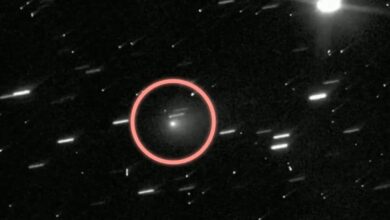Interstellar Comet 3I/ATLAS Spotted Racing Through Solar System

Interstellar Comet 3I/ATLAS: A Visitor From Another Star System
In a rare astronomical event, Comet 3I/ATLAS, an interstellar object, has been observed traversing our solar system. This marks only the third such object ever detected, following in the paths of ‘Oumuamua and Borisov. Discovered by the ATLAS survey on July 1st, Comet 3I/ATLAS offers scientists a unique opportunity to study materials from beyond our solar neighborhood.
A Glimpse into Alien Planetary Origins
According to a statement from the National Science Foundation’s NOIRLab, which oversees the International Gemini Observatory, Comet 3I/ATLAS provides a valuable chance to study the building blocks of alien planetary systems. Martin Still, NSF program director, highlighted the importance of the International Gemini Observatory’s sensitivity and scheduling agility in providing critical early characterization of this interstellar wanderer.
At an estimated diameter of 12 miles (20 km), 3I/ATLAS dwarfs its predecessors, making it significantly easier to analyze. Images reveal a bright, compact coma – the envelope of dust and gas surrounding the comet’s core. Data suggests that the comet may be older than our own solar system, potentially originating from the Milky Way’s outer thick disk. Therefore, 3I/ATLAS may hold clues to the conditions in distant star systems.
Key Features of Comet 3I/ATLAS
- Origin: Believed to originate from the outer thick disk of the Milky Way galaxy.
- Size: Approximately 12 miles (20 km) in diameter, larger than previous interstellar objects.
- Significance: Offers insights into the composition and conditions of planetary systems beyond our own.
- Trajectory: Will make its closest approach to the Sun on October 30th, and to Earth in December.
Observing the Comet’s Journey
Comet 3I/ATLAS is expected to make its closest pass by the Sun on October 30th, when it will fly 130 million miles inside the orbit of Mars. Its closest approach to Earth will occur in December, at a distance of 170 million miles. Due to its unusual orbit, this will be a one-time visit.
Why This Discovery Matters
Astronomers worldwide are focusing their telescopes on Comet 3I/ATLAS, viewing it as a rare chance to examine an object from another star and its planetary system. The comet’s composition and structure can provide valuable information about the formation and evolution of planetary systems beyond our own.
Studying the Comet’s Composition
Analyzing the light reflected from the comet’s coma and tail allows scientists to determine its chemical composition. This can reveal the types of elements and molecules present in the comet, offering clues about the environment in which it formed.
Understanding Planetary System Formation
By studying Comet 3I/ATLAS, astronomers hope to gain a better understanding of how planetary systems form and evolve. The comet’s unique origin and composition may challenge existing theories and provide new insights into the diversity of planetary systems in the galaxy.
Comparing 3I/ATLAS to Previous Interstellar Objects
| Feature | 1I/’Oumuamua | 2I/Borisov | 3I/ATLAS |
|---|---|---|---|
| Type | Asteroid? | Comet | Comet |
| Size | Small | Medium | Large |
| Composition | Unknown | Icy | Likely Icy |
| Discovery Date | 2017 | 2019 | 2025 |
| Notable Features | Unusual Shape | Active | Large Size |
Future Research and Observations
Astronomers plan to continue observing Comet 3I/ATLAS as it travels through our solar system. These observations will provide valuable data about its composition, structure, and trajectory. The information gathered will help scientists refine their models of planetary system formation and evolution.
The Role of Advanced Telescopes
Advanced telescopes, such as the Gemini North Telescope, play a crucial role in studying interstellar objects like Comet 3I/ATLAS. These telescopes provide the sensitivity and resolution needed to capture detailed images and spectra of these faint and distant objects.
Citizen Science Opportunities
Even amateur astronomers can contribute to the study of Comet 3I/ATLAS. By observing the comet and sharing their data, citizen scientists can help track its movement and monitor its brightness changes. This collaborative effort can significantly enhance our understanding of this fascinating interstellar visitor.




